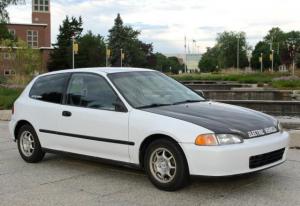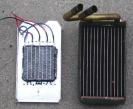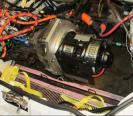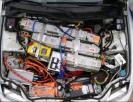| Owner | Paul Pancella | ||||||
|---|---|---|---|---|---|---|---|
| Owner's Other EVs | 2013 Nissan LEAF 2018 Chevy Bolt LT | ||||||
| Location | Kalamazoo, Michigan United States map | ||||||
| Web/Email | WebPage | ||||||
| Vehicle | 1992 Honda Civic CX Hatchback Base model small hatchback, which I bought slightly used in 1993 and drove on gasoline for 15 years. No power steering, no AC, driver has an airbag. | ||||||
| Motor | Lynch LMC-2X2-D127 Permanent Magnet DC Actually two of their largest axial flux motors mounted in tandem by the British electric motor company. Rated 33/68 hp continuous/peak at 144V. Pricey, but only weighs about 50 pounds! Turned out to be the weak link. | ||||||
| Drivetrain | 5 speed manual transmission (S20) to FWD, clutch deleted. | ||||||
| Controller | Kelly KDH14651B Rated for 650A (very briefly) at 144V, 260A continuous. Regenerative braking controlled via a third pedal interface. I've had a few failures over the years. | ||||||
| Batteries | 48 CALB/Skyenergy SE-130AHA, 3.20 Volt, Lithium Iron Phosphate First 4500 miles were on second-hand Saft NiMH, which were less than satisfactory. Replaced with a new set of CALB 130 Ah cells at 197500 miles. | ||||||
| System Voltage | 154 Volts | ||||||
| Charger | Elcon PFC-3000 Level I or Level II, 3 kW max 3 input options: J1772, NEMA 14-50 or 5-20 (120 VAC) | ||||||
| Heater | Nominal 1500 W ceramic electric heating element in place of the old heater core. High/low switch to use all or half of the resistive elements. Good enough. | ||||||
| DC/DC Converter | Iota DLS-30 (Series M) 30 Amps, perfectly adequate. May be disconnected from the traction pack via dashboard switch (to relay). | ||||||
| Instrumentation | Mini-BMS + EV Display. Supplemented with bipolar digital current meter (shunt driven) and digital voltmeters for main pack and 12V system. Quad digital temperature display for controller, motor, and battery groups. | ||||||
| Top Speed | 80 MPH (128 KPH) No problems on highways around here. | ||||||
| Acceleration | About as good as original ICE | ||||||
| Range | 100 Miles (160 Kilometers) This is at ~50 mph, level terrain, warm temperatures, no payload or accessories, but with a generous reserve. Looks like ~80 miles of range at highway speed in the summer or city speeds in an average winter. | ||||||
| Watt Hours/Mile | 200 Wh/Mile Measured at AC supply, moderate speeds and temperatures, no accessories. | ||||||
| EV Miles |
| ||||||
| Seating Capacity | As factory original, 5, although if 3 sat in back they would have to be small. | ||||||
| Curb Weight | 2,275 Pounds (1,034 Kilograms) +/- 20 lbs. ~60% on front axle | ||||||
| Tires | Sumitomo all-season HTR-T4 on very light VX alloy rims. [P165/70 R13] 51 psi on the sidewall, running at ~60 psi. | ||||||
| Conversion Time | Elapsed time: 4 months to first road test. Estimate about 300 man-hours for original NiMH conversion, including myself and everyone else who labored on hardware. Doesn't count design and research/shopping time. Another month and a half to do the lithium upgrade in summer, 2011. | ||||||
| Conversion Cost | Right around $15,000 for the original conversion. Got 10% of that back on my 2009 federal taxes! Added ~$8000 for LiFePO4 battery upgrade, but recouped some of the original expense by selling stuff. | ||||||
| Additional Features | Over 100 Amps of Regenerative Braking capability. Since I have no clutch, I use a third pedal (left foot) to modulate regen independently of factory brakes. Brake lights activated by regen. I retained all of the passenger volume and almost all of the original cargo volume. Rear cargo area floor is raised about 5 cm. 50 Watts of battery heating in foam insulated boxes, thermostat control, from shore power or accessory battery (via 150W inverter). External beeper sounds in reverse gear. The finished car is relatively lightweight, due to the choices on motor and batteries, but those choices raised the cost, too. <200 pounds heavier than original, still 800 lbs. below the GVWR. Aftermarket carbon fiber hood. Replaced right outside mirror with CMOS camera/LCD screen. Solar panels on dashboard help out the 12V battery during daytime driving (and parking). Nearly full belly pan. Dome light and all exterior lights (except headlights) now LEDs. | ||||||
| Retired in summer, 2016. See evalbum.com/4202 for where the battery pack, charger, and other associated parts went. First became operational Thanksgiving 2008 with 132V NiMH pack. Upgraded to 144V early Spring, 2009. Got lots of help from folks online, local buds, and the new Michigan chapter of the EAA ( WebPage ). February 2009 notes: I need to increase to 144 V, so I'll be modifying a battery rack and sending the Zivan NG3 charger back for adjustment. There's plenty of room, and the suspension is sitting right where I left it, so 40 more pounds shouldn't hurt. mid-March 2009: Back on the road at 144V. Got a generous trade-up deal from Kelly, who basically refunded my full original purchase price to go to the new isolated controller. Still have some instrumentation issues, but torque is noticeably improved, and regen is finally working. July 2009: Good thing you can't get these NiMH batteries, they have not performed well. I tried to break them in gently, but apparently the cells were not well balanced from the start. When I went out to test my range in March, I must have damaged some cells, even though I only went 30 miles. I've replaced four of the modules, but I don't know if I've shortened the life of some of the others as well, and they haven't come close to the expected capacity. September 2009: Learning about cell balancing, with no BMS. Can go 20 miles if I'm careful. Still have some weak modules, but I'm reluctant to buy replacements. Saving up for a lithium pack. November, 2009: With considerable effort, I've nursed her back to 30 mile range. I've added some PowerCheq modules to keep the batteries balanced. Finished the fiberglass fairing for the rear-view camera on the right side. Added a relay to shut down the DC-DC converter when the car is off. Voltage sag of the NiMH pack limits me to about 20 kW of motive power. That and the range make the driving experience underwhelming; the extra work to keep the cells manually balanced will eventually make it intolerable. December 2009: Kelly controller blew up, cause unknown. January 2010: Up and running again. Kelly replaced controller under warranty. Added a circuit to light the brake lights when regen is engaged. Now testing to see how she performs in the cold Michigan winter. Not bad down to 12 deg. F. May 2010: Back on the road and running well after a long shutdown. I had some weird issues crop up with the new controller. Replaced some more battery modules while the unit traveled to China and back. Warmer weather making me think about adding the coolant to the batteries. August 2010: Still running well, down to 200 Wh/mile in city driving. Proved regen extends range significantly in normal driving. Got rid of the lead-acid accessory battery in favor of a 4-cell Thundersky LiFePO pack at 20 Ah, taking out another 20 pounds. Finished covering most of the underside, for less drag at speed. December 2010: Miserable cold and rough icy streets here. I'm still using my EV, but useful range is approximately cut in half from summertime best. Handling is excellent, though. February 2011: First hard failure while driving. Last week she suddenly quit about 3 blocks from home, while trying to accelerate away from a stop sign. I found a lug had melted on a cable at the motor, must have shaken loose after 2.5 years on the road. It was a pain to get to it, but I was able to re-lug and re-connect the cable after pulling the car back to my garage. First time I had to rig it for towing with our other car. April 2011: Still nursing the NiMH pack along, but it continues to deteriorate. Now buddying up the worst 10-cell modules with lead-acid AGMs. I doubt it will last another winter. Got my ChargePoint card; now I can recharge for free at work and many other places around town. June 2011: Decent performance in the warmer weather, with three AGM buddies now anchored in. Standard range test route gives 25 miles on a really full charge. July 2011: Lithium upgrade is underway! 48 CALB 130 Ah cells have arrived. Need to design and build new battery trays. This time I will thermally insulate the cells and provide heating elements. Plan to use the mini-BMS distributed system. Looking forward to having a real SoC meter, too. 10 PowerCheq modules and a PakTrakr system will soon be on the Tradin' Post. August 2011 -- Back on the road with lithium power! Everything seems to work great in early testing. Now top-balancing the cells. Still have to finish battery insulation and heater control, but there are a few months before these are needed. September 2011 -- Performance is OUTSTANDING, compared with the NiMH pack. Power is much better now that the voltage barely sags. In the summer, it looks like I can drive 100 miles on a charge and still have a healthy reserve! With so much capacity, level 1 charging now seems slow, plus I need to get the Zivan charger reprogrammed (again) for lithium. Mini-BMS and EV Display work as advertised. It's nice to have an accurate "fuel" gauge. Have taken a few highway trips to nearby towns, no problems. November 2011 -- Just confirmed over 100 miles of in-town range in mild weather. In fact, I went 119 miles and could still accelerate up hill! But this is when I heard the first peep from the LVC alarm of the mini-BMS, indicating that when drawing 150 A, at least one cell went down to 2.5 V. I was the only person aboard for all of these miles, which took place over a week, with temperatures between 50 and 60 F. Top speed was 60 mph, but most of the driving was stop-and-go at 40 mph and less. I used regenerative braking normally and almost no accessories for this test. January 2012 Latest tweaks: Added an audible back-up alarm, automatically sounds when transmission goes in reverse. Cobbled up a small muffler for the output side of the (brake booster) vacuum pump, largely ineffective. Replaced broken radio antenna with one that mounts inside the windshield, capped the exterior hole. Upgraded the accessory battery to a 40Ah LiFePO4 pack (GBS) including the proper smart charger which gets power at the same time as the main charger. Installed a 300W inverter where the ash tray used to be. I can now use it to power the battery heaters from the 12V battery if desired. Late March 2012 -- Turned over 200,000 miles on the odometer. Cold weather performance is excellent. We had a fairly mild winter, but on the coldest days, my range was about 75% of maximum. The mild battery heating seems to help. Independence Day 2012 -- Thanks to prolonged heat wave, I've probed the performance envelope of my EV to higher temperatures. No serious issues so far, but the Zivan charger wants to throttle back when it gets hot. I can unplug the temperature sensor to keep the current up, but I don't know if there are any long term effects on pack capacity. September 2012 -- Re-checked the battery capacity after our record hot summer. Discharged all the way down to the LVC alarm condition, for only the second time. Anyway, there is no measurable change in my battery capacity after over a year of operation (5000 miles), still 140 Ah and cells are balanced and well-matched. 10/20/12: Just clocked 10,000 all-electric miles. February 2013: Have procured a used ElCon charger (3 kW) so that I can make use of level 2 charging. It will probably be a couple of months before I install it, though. Definitely bigger and heavier than the Zivan it will replace. May 2013: Charger upgrade is done and tested. New charge rate now 13+ miles/hour. New unit barely fits under the hood. Also replaced some sheet metal around the right rear wheel which had rusted away, preparing for a possible paint job this summer. June 2013: Took advantage of my new charger and charging infrastructure to make my longest excursion to date. Attended the Michigan EV show 125 miles from home, with a combination of Chargepoints, an RV park, and cooperative motel (level 1 overnight). A smooth and fun trip. I restored the charger drive-off interlock by installing a waterproof microswitch on my charge access door. Still treating rust and smoothing the body. July 2013: Charger was throttling back at level 2 on the hottest days, presumably due to internal thermal protection. Not surprising, since I mounted the Elcon in a very confined space under the [black] hood. I managed to squeeze in some muffin fans that get power from the AC charger supply, and actually pull air through the front grill and over the charger's fins. Now it maintains 3kW all the way to the taper off part of the cycle, using less than 2% more energy for the fans. I even have a bi-metallic thermal switch ($6) strapped to the charger so the fans only come on when it gets hot. Sept. 2013: Got the body work done and had a guy help me re-paint the whole exterior. Now her looks more closely match her performance, sweet! Data point: 10,000 miles on LiFePO4 pack Took exactly 25 months, avg. 400 miles/month 2504 kWh input from all sources, so year-round average is very close to 250 Wh/mile, but trend is down (toward more efficiency). Jan. 2014: Running well in our coldest winter of the decade. After driving around and parking outside in a heavy snowstorm for a few days, I found a disturbing amount of snow distributed under the hood. No impact on operation, but it did make some funny noises when I plugged in to recharge. On a positive note, I confirmed that I have the equivalent of anti-lock braking on my front wheels when I use regen. On a slippery downslope in the neighborhood, applying regen slows the car down as designed. If either front wheel loses traction, the transmission stops turning the motor, and regen cuts out. But it comes back on as soon as the wheels start turning again, if I keep my foot on the regen pedal. Feb. 2014: Really frigid, sub-zero Fahrenheit temperatures for extended periods. No problems in operation, but I lay off the regen when batteries are really cold for fear of internal lithium plating. Range still almost 70 miles in the worst conditions (city speeds). May 2014: Ugh! Motor stopped working, I think it may be brushes. If so, they failed a lot earlier than expected, maybe because of the harsh environment, salty local roads, and I didn't protect them well enough (since I rely on air-cooling). My motor choice and the way I put everything together is going to make brush replacement a big job. There is no way to even inspect half of the brushes without pulling the motor, which also means removing the largest battery rack. July 4, 2014: Yep, that was a big job, no driving for over a month. The two sets of brushes in my tandem motor wore down at very different rates. Sometime during the spring I went past the end of the brushes in the motor closest to the drive end (hardest to access or even see). By the time I got it apart in May a couple of the carbon brushes were completely gone, there was some scoring on the commutator and lots of evidence of arcing. On the other half of the motor, all was fine, and I estimate I had used between 75 and 80% of the brush length. I replaced not only all 16 brushes, but also 4 of the brush sleeves, the torque coupling between the motors, and the original clutch disk which had lost two of its four springs. It took quite a while to clean it up and put everything back together. Also improved the charger supply circuit. Photos have just been updated here. October 2014: Unknown failure. Complete loss of power while driving up a moderate hill at 25 mph, after a few days sitting parked outdoors. Found the main fuse blown, but I have been unable to determine the cause after looking in all the obvious places. May 2015: A busy school year and lousy weather kept me from thoroughly troubleshooting this issue until recently. After replacing the fuse, the error codes reported by the Kelly Controller were not very helpful. Finally determined the controller itself had failed, probably blown FETs. I can no longer get the same model, but an updated version should be plug compatible, and is still relatively inexpensive, so I have one on order. November 2015: The newer model Kelly controller doesn't get along with my motor very well. Extensive back-and-forth with the sales rep failed to resolve the problems. Symptoms are weird and intermittent; could be my motor getting old. I can drive, but I don't have full control of regen like I used to. February 2016: I think we're going to buy a mass-produced EV soon. That means I won't have room for Hondatron (sad). I would sell her whole to a good home at a bargain price, and happily give her new owner all the help I can to make her healthy and useful again. But I realize that I am extremely unlikely to find such a buyer within range. So I'll probably pull the useful parts come spring and scrap the rest. Contact me if you run across this and have any interest. March 2016: Purchased used Nissan Leaf, 2013 model August 2016: Hondatron decommissioned, usable parts harvested and sold. Recouped almost $6000 of my investment. Bottom line: Almost 20,000 electric miles over about 6 good years of use (not counting time offline), net cost around $10k. Learned a lot and had tons of fun. | |||||||
Copyright © 1997-2025 by Mike Chancey










